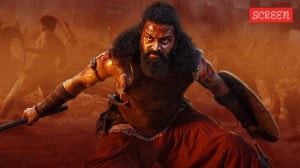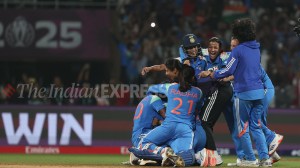Picture the Story
The copper of an age-old story is polished with each retelling it glows warm and beautiful, writes Amruta Patil in the introduction to Adi Parva: Churning of the Ocean,the first book of her Parva trilogy,a graphic retelling of the Mahabharata. Adi Parva,which releases this week,comes four years after her first graphic novel Kari,which presented the desolate world of its eponymous protagonist as well as her wry commentaries on life and love. With Parva,Patil,33,has moved to a bigger canvas,dipping into the vast treasure of stories of the Mahabharata and Vishnu Puran and retelling them through striking visuals and sparse text. In this email interview with Alaka Sahani ahead of the books release,Patil talks about the books circular structure,her fascination with the Mahabharata and how the ideas that rule her work also dictate her personal style:
The copper of an age-old story is polished with each retelling it glows warm and beautiful, writes Amruta Patil in the introduction to Adi Parva: Churning of the Ocean,the first book of her Parva trilogy,a graphic retelling of the Mahabharata. Adi Parva,which releases this week,comes four years after her first graphic novel Kari,which presented the desolate world of its eponymous protagonist as well as her wry commentaries on life and love. With Parva,Patil,33,has moved to a bigger canvas,dipping into the vast treasure of stories of the Mahabharata and Vishnu Puran and retelling them through striking visuals and sparse text. In this email interview with Alaka Sahani ahead of the books release,Patil talks about the books circular structure,her fascination with the Mahabharata and how the ideas that rule her work also dictate her personal style:
With Adi Parva,you have ventured into Indian mythologies. What drew you to them?
The lingering of creative folks at the hemline of the epic has been pre-empted in the very beginning of the Mahabharata: The tree (of the Mahabharat),inexhaustible to mankind as the clouds,shall be as a source of livelihood to all distinguished poets. The allure is ferocious.
Adi Parva is coming out simultaneously in French. How did that happen?
The French Embassy in New Delhi not only hosted the launch of Kari,but also gave me a grant that enabled a year-long writing residency at Angouleme,the comic book city in France. That is where I started scripting Adi Parva. The publishers of the French edition of Kari were,in fact,the first to commission Adi Parva.
Do you see a renewed interest in mythologies?
Aside from what exists among Indophiles,I doubt theres any specific,pressing new interest in Indian mythology in France or anywhere else,maybe even in India. The stories I am dealing with are firmly in the terrain of our shared fears,follies and aspirations. Parva (episode) would presuppose an interest in the human psyche,not in mythology or any Indus-land-isms. I am curious to see what presumptions Adi Parva is met with.
How long have you been living with these mythological characters?
Oh,I reckon Ive been a head-case for about a decade and counting. A friend asked me if I was ever planning to move out of Hastinapur. I may do that in a year or two; I may go on to write stories unpopulated by pictures or by creatures of divine extract but theres no turning back on a personal level.
How have you conceptualised the next two books of the trilogy?
The structure of the trilogy is circular like the extraordinary motif of our subcontinent. Book one contains the creation stories,the love-at-first-sight stories,surreal and vivid landscapes of an innocent epoch. Book two takes us from the naivete to gritty battlefields in the world of mortals. Love stories make way for the brokering of power alliances,frolic in the forest makes way for intrigue inside the palace and rivalries stained with blood. Book three completes the circle,takes us from despair and decimation back into pure colour palettes and playing fields. The sutradhars (narrators) include a celestial-earthly mother,a Chiron-like wounded-healer,and a rabble-rousing messenger who traipses between worlds.
Does the narrative change when a female sutradhar takes charge?
It has more to do with the narrative voice being feminine rather than female one has to do with essence,the other with gender. For that which is masculine,truth is out there. For that which is feminine,truth is in here. (It echoes the physiological functioning of our gendered bodies too,but that is another story). So,when Ganga picks up the thread of the story,she turns the light beam inward instead of outward. It is you,the reader,who wage a continual battle between bird-instinct and reptile-instinct. It is you who is the detached hermit,and you are the apsara who will shatter indifference. The story will always be read at many levels,but Ganga plants the germ of the thought that perhaps the battle of Kurukshetra,just like the Churning of the Ocean,happened nowhere other than inside your mind.
Unlike Kari,there seems to be a burst of bold and bright colours in Adi Parva.
Kari was a binary tale. All ones and zeroes,black and white,you and me,this or that. Karis grey state of mind was served well by the palette. Parva,in contrast,is a circular tale,fractal in structure. It is a loom with countless threads,it contains worlds outside of our dreary reality. How could anything but jewel tones have done it justice?
With Kari,you were celebrated as the first female graphic novelist of India. Do you think Indian graphic novels have come a long way from there?
Its only been four years and a handful of graphic novels,so its a bit premature to come to conclusions. In general,I am more inclined to pay attention to individuals working on love-projects rather than fly-by-night operators looking to cash in on a trend. And love-projects tend to be painstaking and slow processes hard to analyse the scene unless more time and work have come to pass. I think that the Parva trilogy will up the bar vis-a-vis production standards for the graphic novel.
As a graphic novelist what comes to you first words or visuals?
Without doubt,the story.
Why did you choose the graphic novel as a medium?
The allure of bringing together the two things I love words and pictures on one stage. The power that the medium accords to prose that is tightly written,poetic,not lengthy. The way you can draw people in,as if into your parlour; the way you can structure the rhythm,the pace of breathing. The way you can work in silence by holding back text entirely. Theres so much to love. Whats hard about the medium is how time-consuming it is,particularly for single-author works. Just on account of the time-factor,I am inclined to have my post-Parva work be without images. Id like to see if I have it in me to still hold peoples attention without the obvious portals of images.
Tell us about your current project.
I have been awarded a Centre National du Livre (CNL) grant in France. This allows me to spend two months working on the script for Sauptik Parva (book two),while the third month is spent in public engagements. I am speaking about Indian storytelling traditions (ranging from Patachitras to Kaavads to Pandavani to graphic novels) at different venues in different cities in France.
From books to fashion,you seem to have a very individualistic style…
The ideas that govern the work cannot help but spill over into the personal self. I dont like the aesthetics of most store-bought,branded stuff. So I dont wear it. I like Indian fabrics and jewellery,I like what drapes do to my body type and how they affect the way one moves. There is a lot of hand-crafted jewellery and woven apparel that I would have happily worn,but cannot afford. I dont really have that many clothes and am far from being a clotheshorse; but I do try to bring whatever grace and colour I can into the setting I am in.
Tell us about your life in Goa. You seem to be involved in a lot of activity there…
The only activity in Goa that I am involved in is keeping my life sane and simple. I work on my book,pay my bills,tend to cat,kitchen and the plants in my window. I try to buy responsibly,waste less,minimise my consumption,and compost my waste. I try to snap out of being too preoccupied with myself (not easy),and remember birthdays,and focus on my breathing. I run on the beach,and join a bunch of people in keeping the place clean whenever I can. These are very small things,nothing earth-shattering or heroic. But they are as important and as profoundly transforming as rallying in large crowds for changing the course of world events.



- 01
- 02
- 03
- 04
- 05



























